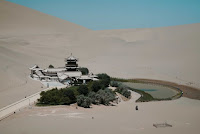At the top of the world a climate disaster is unfolding that will impact the lives of more than 1 billion people.
Deep in the Himalayas sits a remote research station that is tracking an alarming trend in climate change, with implications that could disrupt the lives of more than 1 billion people and pitch the most populated region of the world into chaos.
The station lies in the heart of a region called the Third Pole, an area that contains the largest area of frozen water outside of the North Pole and South Pole.
Despite its relative anonymity, the Third Pole is vitally important; it is the source of Asia's 10 largest rivers including the Yellow, the Yangzi, the Mekong, the Irrawaddy and the Ganges — and their fertile deltas.
Flows from the glaciers that give the pole its name support roughly 1.3 billion people in China, India, Nepal, Pakistan, Bangladesh and Afghanistan — and the glaciers are melting fast.
Chinese authorities have opened up a remote research station on the Qinghai Tibetan Plateau and revealed alarming research on the pace of global warming.
Half a century of research shows the temperature has increased by 1.5 degrees in the area, more than double the global average. More than 500 glaciers have completely disappeared, and the biggest ones are retreating rapidly.
Read more at Crisis on High

No comments:
Post a Comment